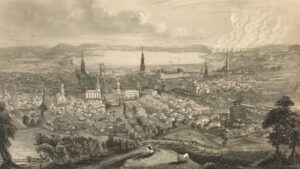
The Onondaga Citizens League (OCL), founded in 1978, was a unique membership organization open to all citizens who were interested in looking at issues that affected the community’s economic health and quality of life. Its primary mission was to foster informed public discourse by identifying and studying critical community issues affecting Central New York, developing recommendations for action, and communicating study findings to interested and affected groups.
The organization was initially formed out of programs conducted by Syracuse University’s Thursday Morning Roundtable (TMR). In 1976, members of this civic forum group traveled to Toronto, Canada for two days of meetings with officials on the subject of metropolitan government.
In Toronto, a presentation was given by Arthur Naftalin, a well-known official from Minneapolis. He described the long, successful experience of the Minneapolis-St. Paul Citizens League. That organization, the best known of several citizens’ leagues in the U.S., had been instrumental in much of the progress made by metropolitan government in the Twin City area.
Members of the Syracuse group were impressed with this example of citizen participation in public affairs. Upon returning to Syracuse, several Roundtable members, supported by county officials, mapped plans to develop a local version of the Minneapolis-St. Paul League. Assisted by several local planning groups, the Roundtable brought Arthur Naftalin to Syracuse for a series of meetings. This resulted in the development of a local organizing group of twenty members, mostly TMR members, and the adoption of the name “Onondaga Citizens League”.
The OCL’s study process involved community members in exploring critical issues, spurring community conversations, and influencing public policy considerations. OCL’s timely and relevant reports shed light on important community concerns and were often used as a resource by governments, nonprofit groups and others in moving forward on solutions to long-standing problems. A full list of OCL’s studies can be found below. The most recent studies can be downloaded from CNYVitals.org. For copies of older studies, contact us at info@cnycf.org.
In 2020, OCL merged with Syracuse 20/20, a civic engagement organization that held a similar mission. Formed in 1999, Syracuse 20/20 worked to combat urban deterioration and to improve the general quality of life and economic opportunity within the city of Syracuse through active involvement of the city’s private sector. The organization undertook nonpartisan analysis, study and research to determine the priority issues and challenges confronting the city of Syracuse in the areas of education, housing, economic development, and government modernization. It then released information and community-based solution recommendations to the general public.
In 2022, leaders decided to dissolve the combined organization and allocate remaining funds to the Onondaga Citizens League-Syracuse 20/20 Fund. This fund will continue the mission and vision of OCL and Syracuse 20/20 by serving as a catalyst for positive change in Central New York through heightened and inclusive citizen engagement to enhance the community’s quality of life for all. This fund will support efforts including the study of issues, citizen convenings, and diverse grassroots civic actions, that are designed to create an environment of informed interaction and civil discourse aimed at the implementation of tangible and beneficial change and long-term sustainability.
Onondaga Citizens League’s Community Studies
2017-2018: The State of the Community Engagement Infrastructure of Central New York
2015-2016: How CNY Moves
2014: Understanding the Employment Skills Gap in CNY
2013: Early Childhood and School Readiness: Creating a Community Where All Children Thrive by Five
2012: The World at Our Doorstep
2010-2011: Community Image: Valuing Our Public Spaces
2009-2010: What Does It Mean to Be Green?
2008-2009: Rethinking I-81
2007: How Inequality Makes Us Sick: The Growing Disparities in Health and Health Care
2006: Fixing the Hub: Leveraging Better Outcomes for Downtown
2005: Strategic Government Consolidation
2004: Disappearing Democracy: A Report on Political Participation in Onondaga County
2003: Mental Health Services
2002: The State of the Arts
2001: Civic Leadership for Community Transformation
2000: Housing & Neighborhoods: Tools for Change
1999: Successful Economic Development Models: Lessons for Central New York
1998: Onondaga County School Systems
1997: Security Check: Personal Perceptions of Safety & Security
1996: Building a Non-Violent Community: Successful Strategies for Youth
1995: Reinvesting in the Community: Opportunities for Economic Development
1994: The Delivery of Human Services: Opportunities for Improvement
1993: The Criminal Justice System in Onondaga County: How Well Is It Working?
1992: Town and Village Governments: Opportunities for Cost-Effective Changes
1991: Schools that Work: Models in Education that can be used in Onondaga County
1990: Syracuse Area Workforce of the Future: How Do We Prepare?
1989: Poverty and Its Social Costs: Are There Long-Term Solutions?
1988: The Role of the Food Industry in the Economy of Onondaga County
1986-1987: Blueprints for the Future: Recommendations for the Year 2000
1985: The City and County Charters: Time for Revision?
1984: Police Services in Onondaga County: A Review and Recommendations
1983: Onondaga County Public Works Infrastructure: Status, Funding, and Responsibilities
1982: Declining School Enrollment: Opportunities for Cooperative Adaptations
1981: The County Legislature: Its Function, Size, and Structure
1980: Young People in Trouble: Can Our Services Be Organized and Delivered More Effectively?
1979: Equality and Fairness in Property Assessment
Donate Now